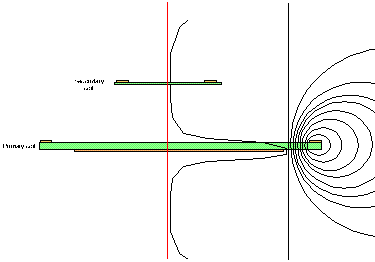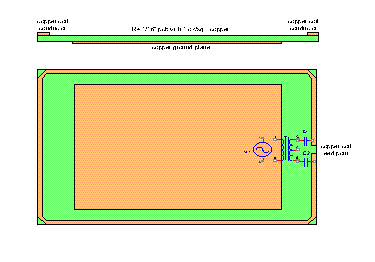[Date Prev][Date Next][Thread Prev][Thread Next][Date Index][Thread Index]
Re: [femm] PM modeling (Re:Suggestions)
Hello,
I am trying to solve a seeminlg simple problem.... which seems to be getting more and more difficult as time goes by.
I have a simple, one turn quasi rectangular coil, printed on a printed circuit. It carries 25 Amps of RF (13 MHz) power. This coil is used as the primary of an air transformer (no high perm core) and is tuned with a series capacitive feed to resonate at our frequency.
The secondary of this transformer is a mobile device that can be placed in proximity of the primary coil. It draws energy from the magnetic filed emanating from the primary coil. Solving the problem of knowing how much energy, voltage and current is available in free space above the coil was trivial, and that works fine.
At some point we started to mount our electronic circuits inside the loop so that the whole lectroinc assembly would be on a single board. We placed asolid ground plane where our circuit resides so that the RF field gnereated by the coil would be shunted out and thus would not poison the electroincs inside the coil.
All of this worked fine. With time, we increased the amount of electroincs and therefore the size of the ground plane. As expected, this reduced the inductance of the coil. All is still fine.
Now for the problem: We want to model the magnetic field over the coil to predict the power that will be picked up by the mobile coil hovering over our fixed coil. That was easy when the coil was empty in the middle. As our ground plane expands, we are finding that the flat aspect of our coil wire, the presence of the ground plane, etc, is making analytical prediction of the field more and more difficult... (thereby my interest in your FEMM program). I hope we can use FEMM to model this rather than having to go by the experimental route. We are curious as the the results FEMM or another modeling technique may yield as we are finding that the RF field at a height of 75% of the coil size is actually increasing as the ground plane fills in a more significant portion of the air space within the coil.
Question: can this be modeled by FEMM?
Ivan Reede
------=_NextPart_001_0115_01C0FE4D.8CE18260
Content-Type: text/html;
charset="iso-8859-1"
Content-Transfer-Encoding: quoted-printable
<!DOCTYPE HTML PUBLIC "-//W3C//DTD HTML 4.0 Transitional//EN">
<HTML><HEAD>
<META http-equiv=Content-Type content="text/html; charset=iso-8859-1">
<META content="MSHTML 5.50.4522.1800" name=GENERATOR>
<STYLE></STYLE>
</HEAD>
<BODY bgColor=#ffffff>
<DIV><FONT size=2>Hello,</FONT></DIV>
<DIV><FONT size=2></FONT> </DIV>
<DIV><FONT size=2>I am trying to solve a seeminlg simple problem.... which seems
to be getting more and more difficult as time goes by.</FONT></DIV>
<DIV><FONT size=2></FONT> </DIV>
<DIV><FONT size=2>I have a simple, one turn quasi rectangular coil, printed
on a printed circuit. It carries 25 Amps of RF (13 MHz) power. This coil isused
as the primary of an air transformer (no high perm core) and is tuned with a
series capacitive feed to resonate at our frequency.</FONT></DIV>
<DIV><FONT size=2></FONT> </DIV>
<DIV><FONT size=2>The secondary of this transformer is a mobile device that can
be placed in proximity of the primary coil. It draws energy from the magnetic
filed emanating from the primary coil. Solving the problem of knowing how much
energy, voltage and current is available in free space above the coil was
trivial, and that works fine.</FONT></DIV>
<DIV><FONT size=2></FONT> </DIV>
<DIV><FONT size=2>At some point we started to mount our electronic circuits
inside the loop so that the whole lectroinc assembly would be on a single board.
We placed a solid ground plane where our circuit resides so that the RF field
gnereated by the coil would be shunted out and thus would not poison the
electroincs inside the coil.</FONT></DIV>
<DIV><FONT size=2>All of this worked fine. With time, we increased the amount of
electroincs and therefore the size of the ground plane. As expected, this
reduced the inductance of the coil. All is still fine.</FONT></DIV>
<DIV><FONT size=2></FONT> </DIV>
<DIV><FONT size=2>Now for the problem: We want to model the magnetic field over
the coil to predict the power that will be picked up by the mobile coil hovering
over our fixed coil. That was easy when the coil was empty in the middle. As our
ground plane expands, we are finding that the flat aspect of our coil wire,the
presence of the ground plane, etc, is making analytical prediction of the field
more and more difficult... (thereby my interest in your FEMM program). I hope we
can use FEMM to model this rather than having to go by the experimental route.
We are curious as the the results FEMM or another modeling technique may yield
as we are finding that the RF field at a height of 75% of the coil size is
actually increasing as the ground plane fills in a more significant portionof
the air space within the coil.</FONT></DIV>
<DIV><FONT size=2></FONT> </DIV>
<DIV><FONT size=2><IMG
src="cid:011201c0fe6f$13dab860$1901a8c0@xxxxxxxxxxxx";></FONT></DIV>
<DIV><FONT size=2></FONT> </DIV>
<DIV><IMG src="cid:011301c0fe6f$13e25980$1901a8c0@xxxxxxxxxxxx";></DIV>
<DIV><FONT size=2>Question: can this be modeled by FEMM?</FONT></DIV>
<DIV><FONT size=2></FONT> </DIV>
<DIV><FONT size=2>Ivan Reede</FONT></DIV>
<DIV><FONT size=2></FONT> </DIV></BODY></HTML>
------=_NextPart_001_0115_01C0FE4D.8CE18260--


